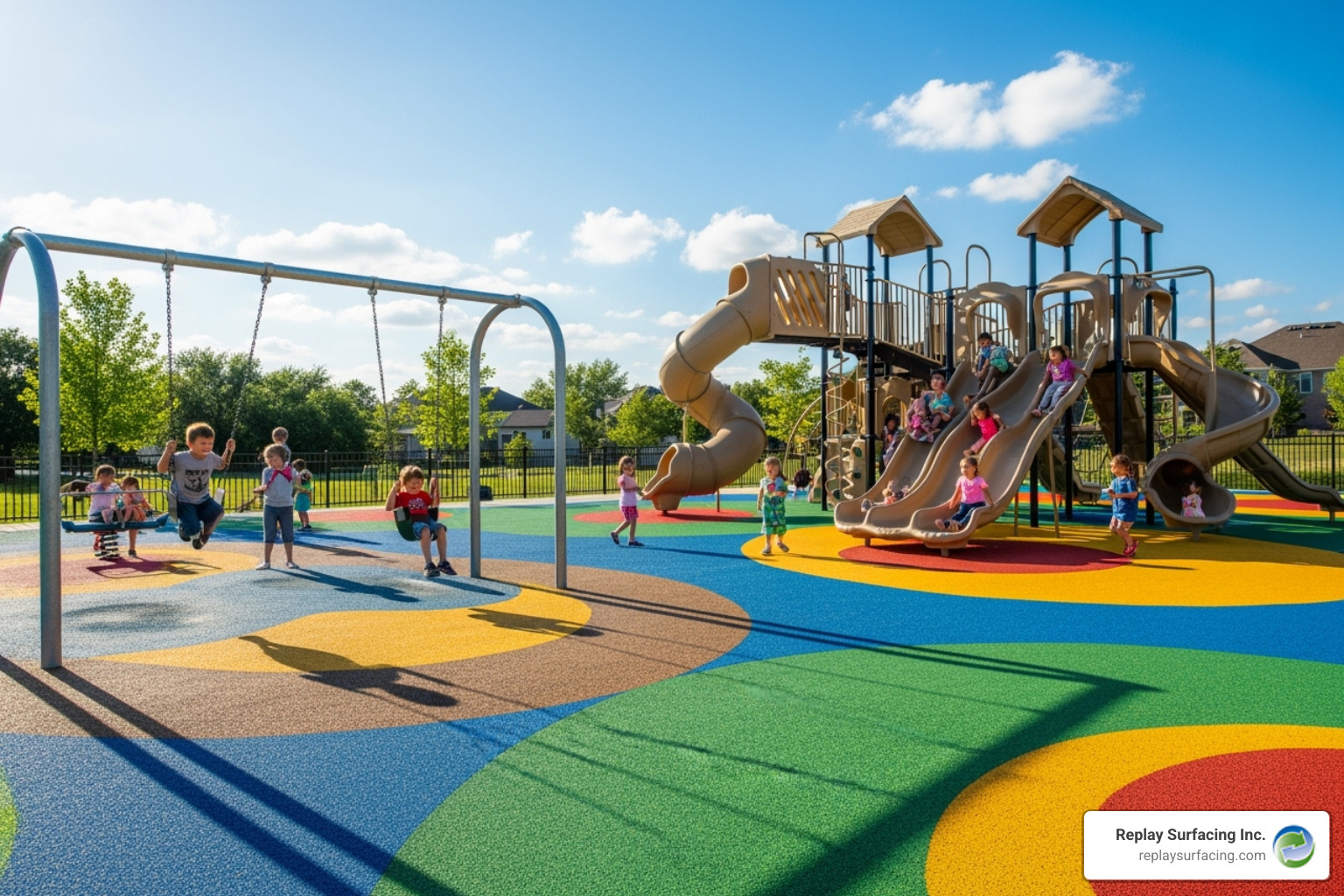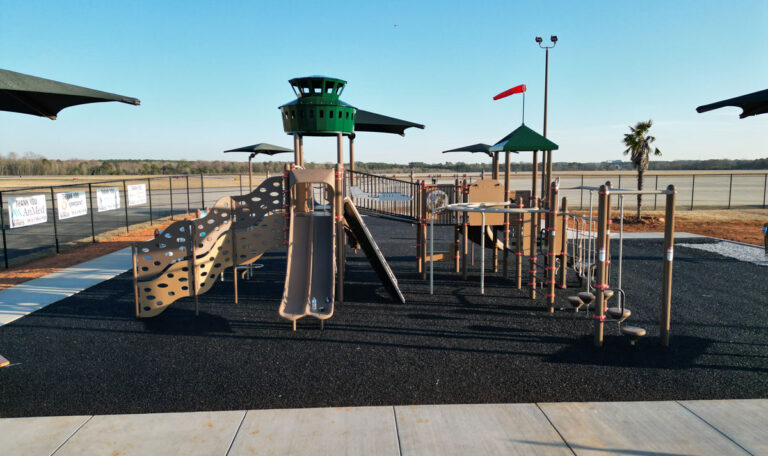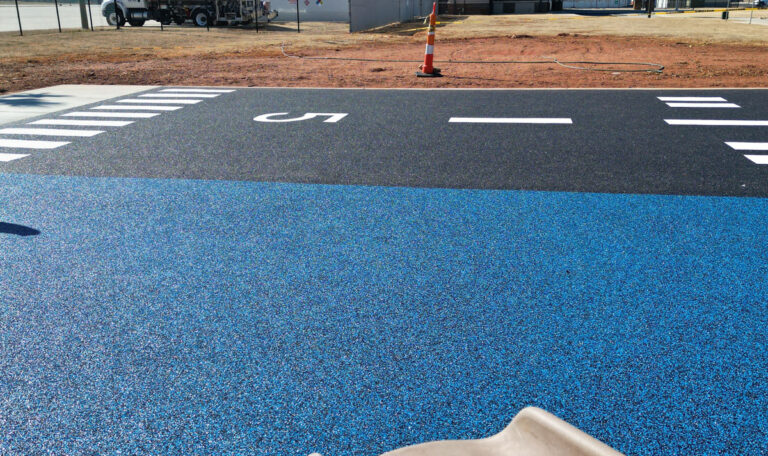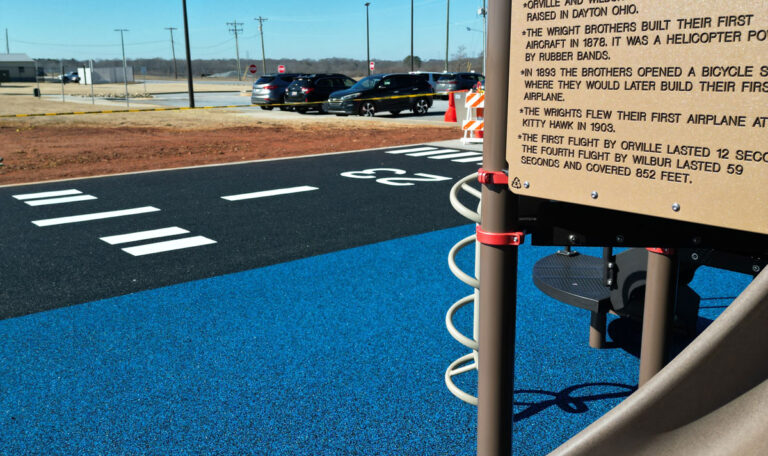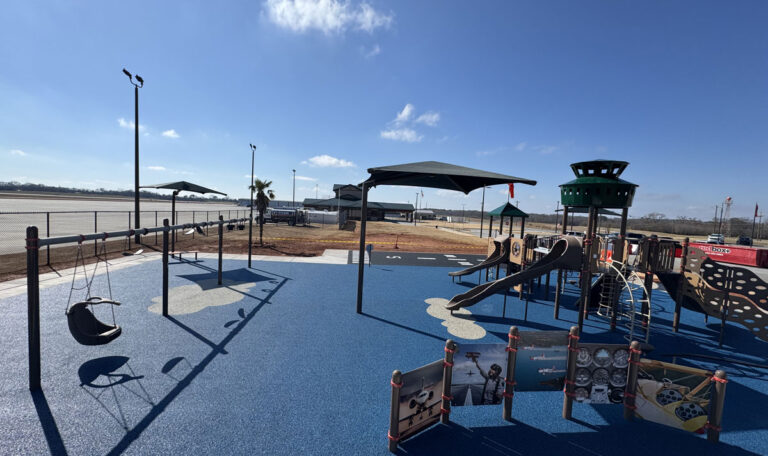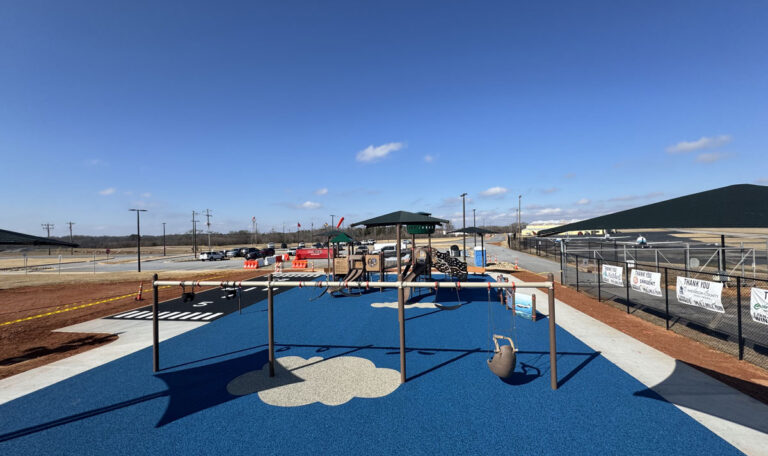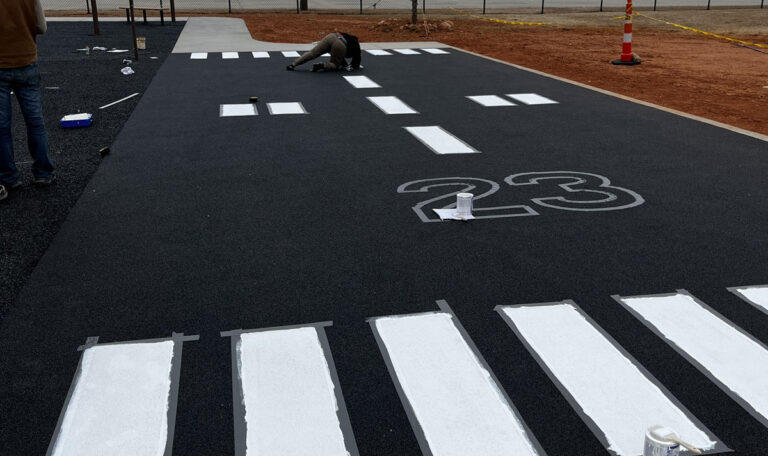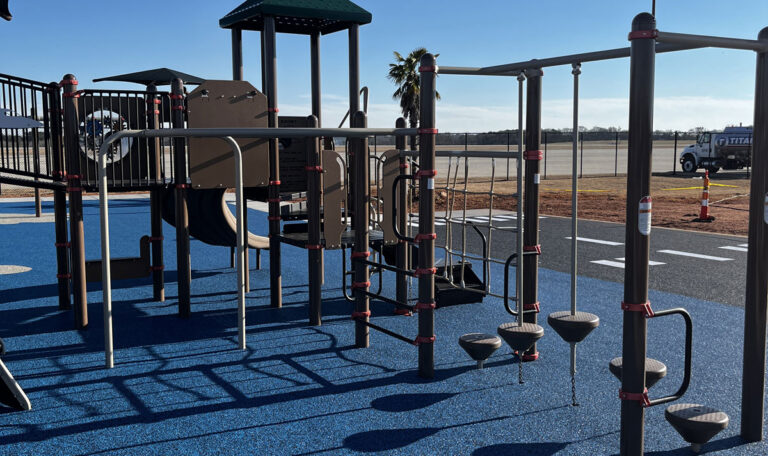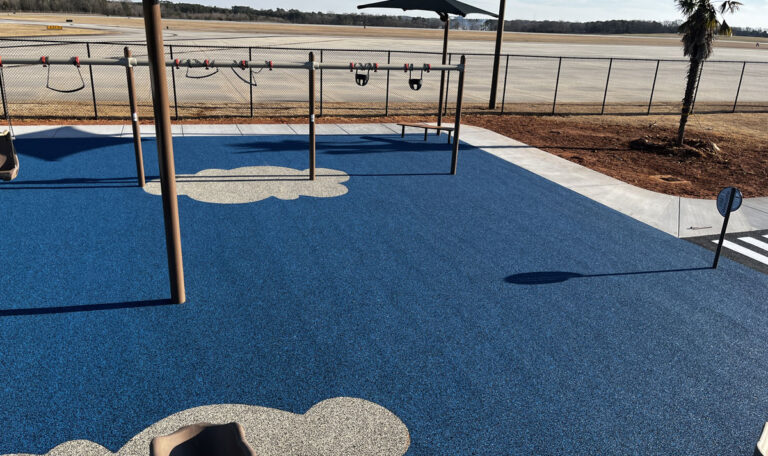Understanding the True Cost of Rubber Mulch in Charlotte, NC
The cost of rubber mulch per yard typically ranges from $120 to $250, depending on several key factors that impact your final investment:
Quick Cost Breakdown:
- Bulk rubber mulch: $120-$180 per cubic yard
- Bagged rubber mulch: $200-$250 per cubic yard (requires 33-34 bags of 0.8 cu ft each)
- Professional installation: Additional $0.20 per square foot
- Delivery fees: $50-$100 depending on location and quantity
While rubber mulch costs significantly more upfront than wood mulch ($30-$40 per yard), it lasts 10+ years without replacement, making it cost-effective long-term. Made from 100% recycled tires, rubber mulch offers superior safety for playgrounds with fall height protection up to 16 feet when installed at proper depths.
The higher initial investment reflects rubber mulch’s durability, safety features, and environmental benefits. Unlike organic mulches that decompose annually, rubber mulch maintains its protective qualities and vibrant colors for over a decade with minimal maintenance.
I’m Landon Olson, a mechanical engineer with an MBA. Through my work at Replay Surfacing, I’ve spent years helping facility managers understand the true cost of rubber mulch per yard. My goal is to guide you in making an informed investment that balances upfront costs with decade-long performance and safety.
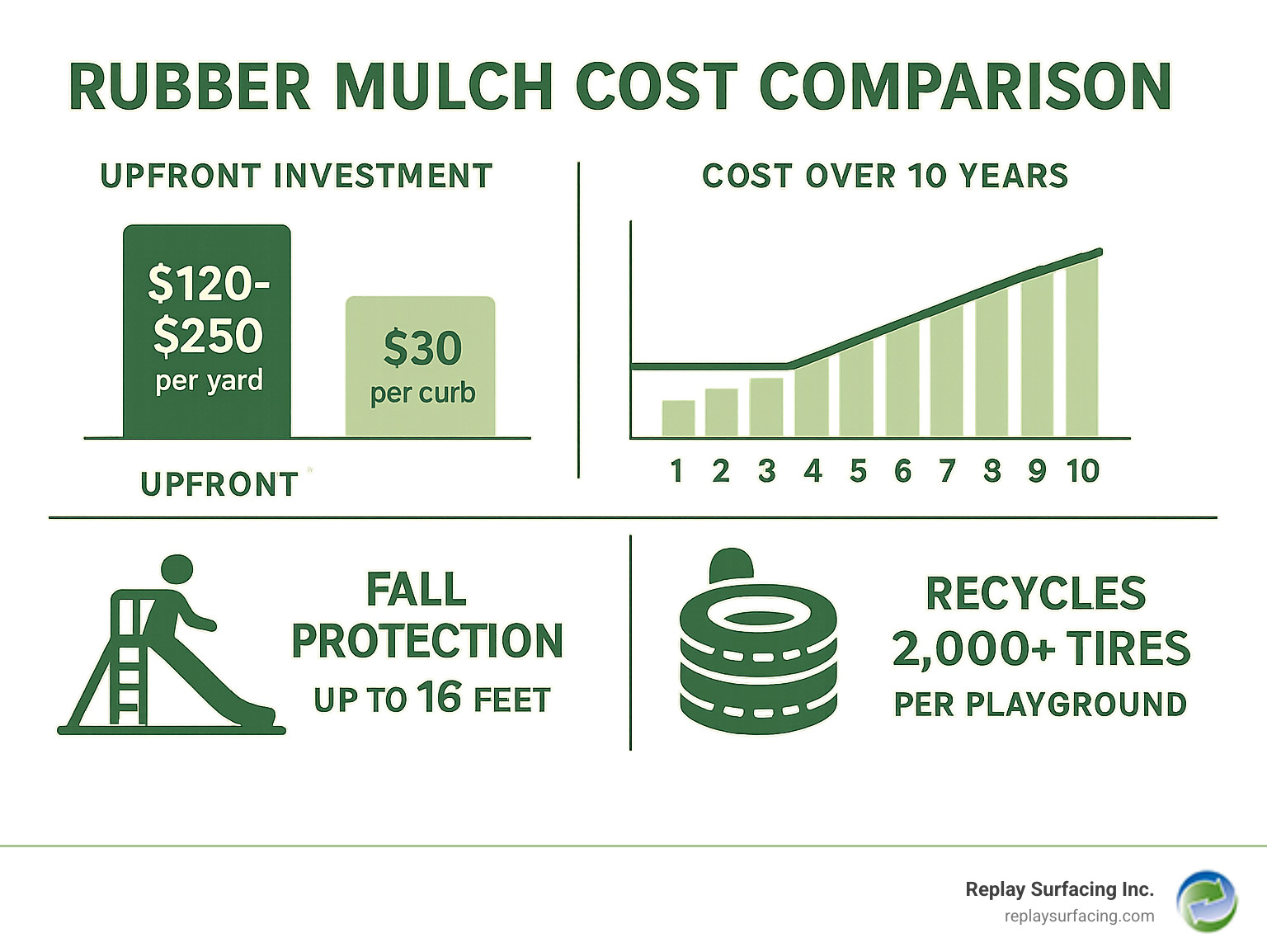
Know your cost of rubber mulch per yard terms:
Understanding Rubber Mulch: Composition and Types
Before diving deeper into the cost of rubber mulch per yard, it’s important to understand what you’re investing in. Rubber mulch is one of recycling’s greatest success stories, changing discarded tires from environmental hazards into vibrant, durable surfacing material.
The journey from old tire to playground surface is remarkable. Instead of piling up in landfills, used tires get a second chance through companies like Replay Surfacing. Our manufacturing process involves shredding used auto and truck tires and removing 99.99% of all steel components, ensuring the final product is safe for children and landscaping.
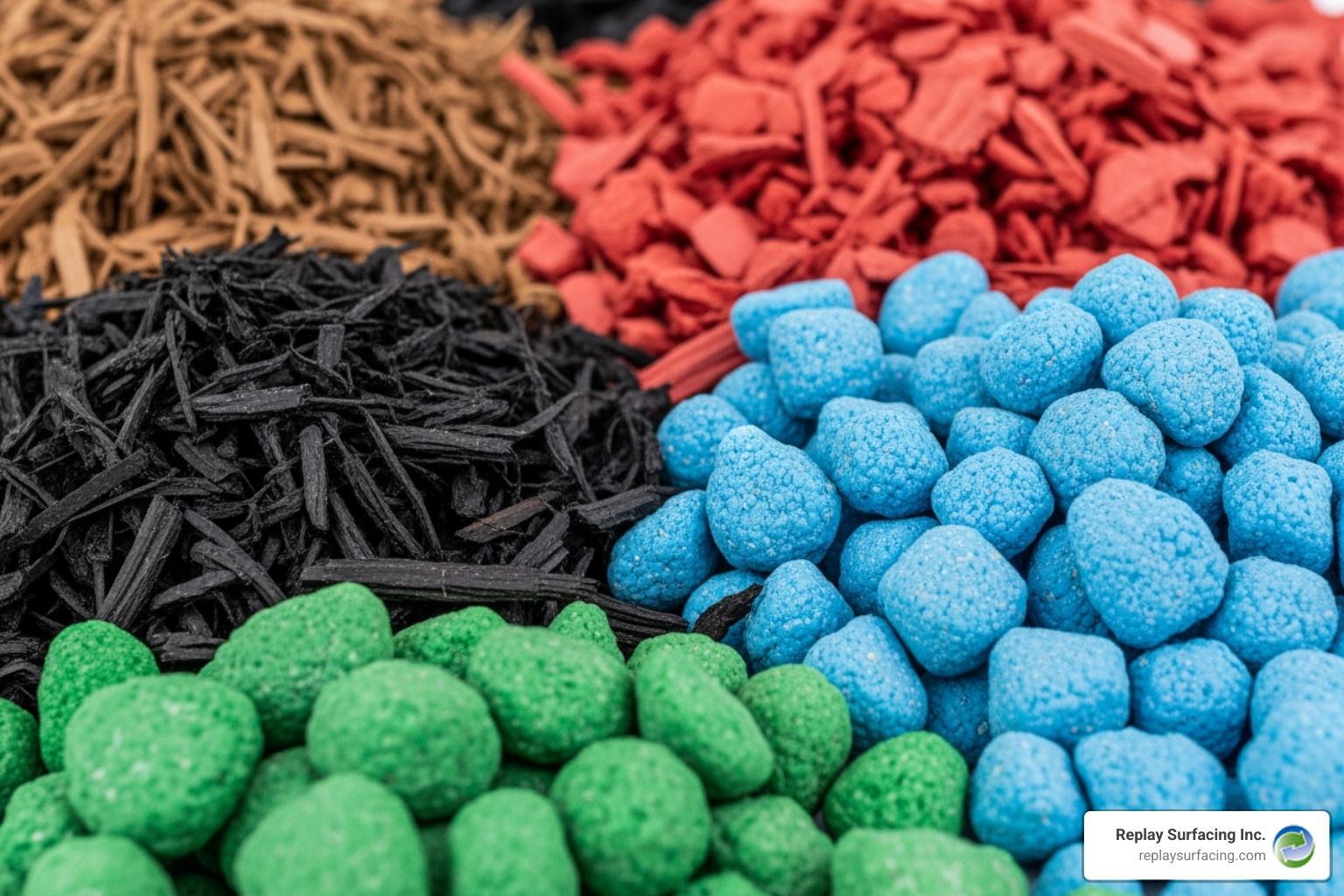
What makes rubber mulch particularly appealing is its durable polyurethane coating, which chemically bonds with the material for lasting color and wear resistance. This is why rubber mulch maintains its vibrant appearance for over a decade, whether you’re installing it in the sunny climate of Tucson, AZ, or the varied weather conditions of our service areas in Indiana or Connecticut.
When considering rubber mulch options, you’ll encounter two main types that affect both performance and the cost of rubber mulch per yard. Shredded rubber mulch consists of irregular pieces (3/8″ to 3/4″) that interlock when installed, creating excellent stability that resists wind and water displacement—a crucial feature for playground safety.
Rubber nuggets offer a different aesthetic with their more uniform, chunky appearance. They serve the same safety and durability functions but are often chosen for specific design preferences.
For ultimate durability, bound rubber mulch is a premium option. This system combines rubber granules with binders to create a seamless, poured-in-place surface. While the upfront investment is higher, it eliminates ongoing maintenance.
The loose rubber mulch option remains popular for its versatility and easier installation. Whether for a DIY backyard project or a commercial installation in our service areas, loose rubber mulch offers a great balance of safety, durability, and cost-effectiveness.
Color selection is also important. From natural earth tones to bright primary colors, the variety available ensures every project can match its unique vision.
The Real Cost of Rubber Mulch Per Yard
When researching options, the cost of rubber mulch per yard can feel like sticker shock. Seeing prices from $120 to $250 per cubic yard makes you pause, especially when wood mulch is $30 to $80. But I always tell customers in our service areas from Charlotte, NC, to Beaverton, OR, to look beyond that initial number.
Think of it like buying a quality winter coat versus a flimsy jacket. The higher upfront cost of rubber mulch per yard reflects a material engineered to last over a decade without replacement, saving you money long-term.
Let me break down what you’re really looking at cost-wise across different options we offer at Replay Surfacing:
| Mulch Type | Upfront Cost (per cubic yard) | Lifespan (years) | Annual Replacement Cost (if applicable) | Estimated 10-Year Cost (excluding installation) |
|---|---|---|---|---|
| Wood Mulch (Dyed) | $40 – $80 | 1 – 2 | $40 – $80 | $200 – $800 (5-10 replacements) |
| Loose Rubber Mulch | $120 – $250 | 10+ | $0 | $120 – $250 |
| Bonded Rubber Mulch | ~$1600 – $2500 (estimated) | 10+ | $0 | ~$1600 – $2500 |
Note: Bonded rubber mulch costs are often quoted per square foot due to its different application method (poured-in-place). The cubic yard estimate for bonded rubber mulch is a rough conversion for comparison, assuming a typical depth. Actual costs may vary.
The math is compelling. While you might spend $250 on rubber mulch today, that same area could cost you up to $800 over ten years with wood mulch. That’s real money that stays in your pocket.
What drives these price differences? Several factors influence the cost of rubber mulch per yard in markets across our service areas like Nashville, TN, and Raleigh, NC. Color selection plays a role, as specialty colors cost more than earth tones. Type matters too, with nuggets costing more than shredded varieties. Quantity is your friend here, as bulk orders significantly reduce per-yard costs.
For detailed insights into how these costs apply specifically to playground projects, I recommend checking out our comprehensive guide on Understanding Rubber Playground Surfacing Costs.
Breaking Down the Cost of Rubber Mulch Per Yard
The way you buy rubber mulch dramatically affects the price. It’s like buying in bulk at the grocery store—the upfront cost is higher, but the per-unit price is lower.
Bagged mulch is the most accessible option for small projects. Most bags contain 0.8 cubic feet, so you’ll need about 34 bags for one cubic yard. At roughly $6 per bag, you’re looking at around $204 per yard. This works for a small backyard playset, but the premium adds up on larger jobs.
Bulk purchasing changes the game. When you order by the cubic yard or ton, you bypass packaging costs. Bulk rubber mulch typically runs between $120 and $180 per cubic yard—a significant saving. This is the best approach for community playgrounds and large commercial or residential projects throughout our service areas.
Pallets and super sacks offer a middle ground for medium-sized projects, providing bulk pricing benefits without requiring a full truckload. For more information, explore our guide on Rubber Mulch Per Ton.
Delivery fees add another layer to your budget. Depending on your location and quantity, delivery typically ranges from $50 to $100. Larger orders often qualify for reduced or free delivery, making bulk purchases even more attractive.
Long-Term Value: Is Rubber Mulch Cost-Effective?
This long-term value is where rubber mulch truly shines, making the initial cost of rubber mulch per yard a smart investment.
Longevity is its superpower. While wood mulch needs annual replacement, rubber mulch maintains its protective qualities for 10+ years. Some products even come with 12-year color warranties. Imagine installing your surface once and not thinking about it for a decade.
Zero annual replacement costs mean no more spring mulching marathons. That annual ritual—along with its costs—disappears from your maintenance schedule.
Reduced maintenance extends beyond replacement. Rubber mulch doesn’t blow away, wash out, or compact. It maintains its depth and coverage with minimal intervention, typically just an occasional raking to clear debris.
Studies show rubber mulch can save up to 65% over five years compared to wood mulch when factoring in labor. That cost of rubber mulch per yard transforms from an expense into an investment that pays dividends.
For a deeper dive into these lasting benefits, I encourage you to read our comprehensive analysis: Advantages of Playground Rubber Mulch: Safety, Maintenance, and Durability.
Pros and Cons of Rubber Mulch: A Balanced View
When you’re investing in the cost of rubber mulch per yard, you want the complete picture. At Replay Surfacing, we believe in giving our customers across Nashville, Charlotte, and all our service areas a balanced look at the pros and cons.

Key Advantages of Using Rubber Mulch
The biggest game-changer is superior safety, especially for playgrounds. When a child takes an inevitable tumble, rubber mulch provides incredible shock absorption that can prevent serious injury.
A 6-inch layer of rubber mulch can protect against falls from up to 16 feet high, exceeding ASTM safety guidelines for playgrounds and meeting crucial US CPSC and IPEMA standards. For families in Raleigh or Columbia looking at rubber mulch for playset applications, this safety factor alone often justifies the higher cost of rubber mulch per yard.
The durability factor is key to its long-term value. While wood mulch in Connecticut winters might rot or splinter, rubber mulch stays put. It doesn’t compress, decompose, or wash away, maintaining its protective qualities for over a decade.
Low maintenance is a reality with rubber mulch. No more annual spreading sessions or watching your investment wash away. A quick rake or leaf blower session a few times a year is all it needs.
Weed suppression and pest deterrence are natural bonuses. Rubber mulch blocks sunlight, preventing weed growth, and is unappealing to termites and other pests that love organic materials.
Potential Drawbacks and Considerations
Now for the challenges. The higher initial investment is real. Comparing $40 wood mulch to $180 rubber mulch per yard can be a shock, and the upfront cost can strain some budgets, despite the long-term savings.
Flammability deserves consideration, especially in fire-prone areas. The Consumer Reports flammability test found that rubber mulch can burn faster and hotter than wood mulch once ignited. This is important for customers in areas with dry conditions like Tucson.
Heat absorption can be noticeable, especially with darker colors on sunny days. Surfaces can become warm to the touch during peak summer hours. Lighter colors can help mitigate this.
Health considerations are worth discussing. While our rubber mulch is 99.99% metal-free, some have concerns about potential chemical leaching. The American Lung Association provides helpful information on VOCs, and we address these concerns in our article Is Rubber Mulch Toxic?.
Finally, rubber mulch is difficult to remove once installed. Its weight and interlocking nature make changing your landscaping design a significant project.
Despite these points, for customers in our service areas who prioritize safety, durability, and long-term value, rubber mulch remains an excellent investment. The key is understanding both sides to make the right decision.
Installation: DIY vs. Professional Costs
Once you’ve chosen rubber mulch, you must decide: DIY or professional installation? This choice significantly impacts your budget, and both approaches have merit depending on your project in areas like Charlotte, NC, or Lake Charles, LA.
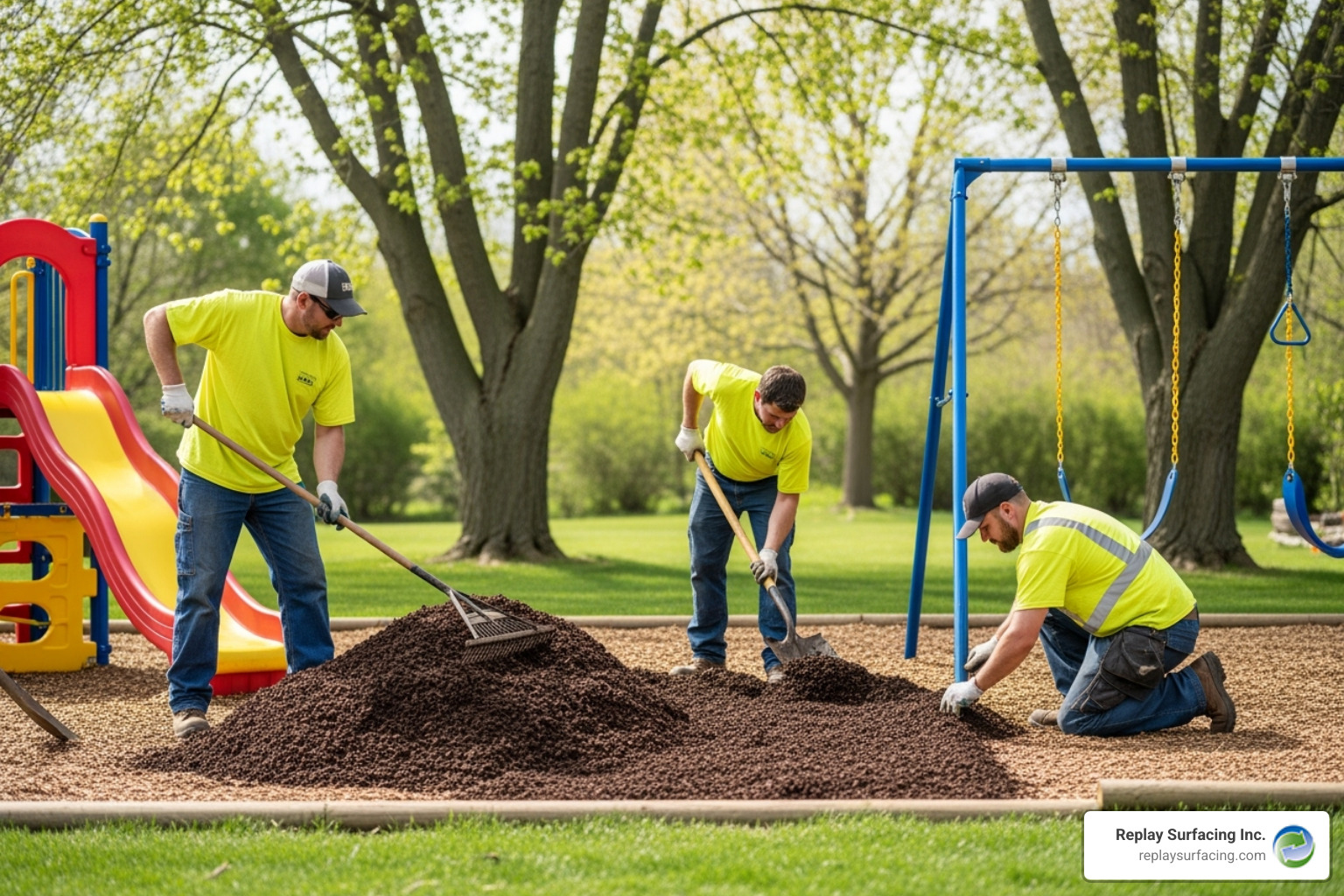
The installation method you choose impacts your overall project budget beyond just the cost of rubber mulch per yard. Let’s walk through both options.
DIY Rubber Mulch Installation
Doing it yourself can be satisfying, especially for smaller projects like a backyard play area in Nashville, TN, or landscaping beds in Columbia, SC.
The process is straightforward but requires some elbow grease. First, measure your space accurately (length, width, depth). For landscaping, 1-2 inches is fine, but playgrounds need 3-6 inches for residential use and a minimum of 6 inches for commercial sites to meet safety standards.
Next, prepare the area by clearing all debris, leveling the ground, and ensuring proper grading. For playgrounds, installing borders to contain the mulch is a good idea.
Then, lay landscape fabric. This crucial step prevents the mulch from mixing with soil, improves weed control, and is a small cost for a big benefit.
Finally, spread the mulch evenly with a rake and shovel. The tools you’ll need are basic: a measuring tape, shovel, rake, wheelbarrow, and a utility knife.
The total DIY cost is your time and energy, saving you labor fees. For step-by-step guidance, our Installing Rubber Mulch guide has you covered.
Hiring a Professional
For larger projects, like a community playground in Beaverton, OR, or extensive commercial landscaping in Raleigh, NC, professional installation often makes the most sense.
Professional labor costs typically run around $0.20 per square foot, with minimum fees starting around $50. While landscapers charge $14 to $25 per hour per person, their efficiency on large projects can save you time and money.
The benefits of professional installation include speed and expertise. A pro crew can finish in hours what might take you a full weekend. More importantly, they bring expert preparation skills, handling grading, drainage, and border installation critical for longevity and safety.
For playgrounds, safety compliance is paramount. Professionals ensure your mulch meets the exact depth requirements for safety standards, giving you peace of mind.
Professionals also deliver a seamless finish, with the experience and equipment to achieve a perfectly level, aesthetically pleasing look.
Finding qualified contractors in our service areas from Sanford, NC, to Tucson, AZ, is straightforward. We work with experienced teams who can provide comprehensive quotes covering material and labor, typically ranging from $215-$235 per 100 square feet. While higher than DIY, you get the assurance of an expert installation that will perform for years.
The choice comes down to your project size, timeline, and comfort level. Either way, you’ll end up with a durable, safe surface that makes the cost of rubber mulch per yard a smart investment.
Frequently Asked Questions about Rubber Mulch Costs
Planning a rubber mulch project can feel overwhelming. Whether you’re a homeowner in Columbia, SC, or a facility manager in Nashville, TN, these common questions will help you steer the cost of rubber mulch per yard with confidence.
How many bags of rubber mulch are in a cubic yard?
Most rubber mulch bags contain 0.8 cubic feet of material. Since a cubic yard equals 27 cubic feet, you’ll need approximately 34 bags to cover one cubic yard (27 ÷ 0.8 = 33.75 bags).
This calculation is key when comparing prices. If bags are $6 each, you’re looking at roughly $204 per cubic yard for the material, plus the hassle of handling dozens of bags.
Is buying rubber mulch in bulk cheaper per yard?
Absolutely. The savings from buying in bulk can be substantial.
Bagged rubber mulch typically costs $200-$250 per cubic yard. In contrast, bulk rubber mulch ranges from $120-$180 per cubic yard. That’s a potential savings of $70-$130 per yard.
The savings become even more impressive with larger orders, as many suppliers, including Replay Surfacing, offer volume discounts. A full truckload can bring your per-yard cost down even further.
Delivery considerations also favor bulk. A single delivery fee of $75-$100 for a bulk order to your Raleigh, NC, or Tucson, AZ, location is more efficient than multiple trips to the store for bags.
What factors most influence the cost of rubber mulch per yard?
Several key elements determine your final cost of rubber mulch per yard.
- Color selection: Natural black or brown mulch costs less than vibrant reds, blues, or greens, which require specialized dyes. Choosing earth tones for a playground in Charlotte, NC, can save you $10-$30 per yard.
- Material type: Shredded rubber mulch is the most economical, while rubber nuggets cost slightly more. Premium bound rubber mulch is the highest investment.
- Quantity: Bulk purchasing dramatically reduces your per-yard cost, especially when volume discounts for large orders kick in.
- Supplier quality: At Replay Surfacing, our commitment to 99.99% metal-free processing and rigorous quality control ensures a safer, more durable product that meets all safety standards for playgrounds in our service areas from Sanford, NC, to Beaverton, OR.
- Geographic location: Proximity to distribution centers affects delivery fees. Remote locations may have higher transportation costs.
Conclusion: Making the Right Choice for Your Project
While the $120 to $250 cost of rubber mulch per yard might seem high compared to wood chips, the best investments aren’t always the cheapest upfront. You’re not just buying mulch; you’re buying a decade of peace of mind.
No more weekend trips to the garden center, aching backs from spreading mulch, or worrying if your playground surface is safe. While wood mulch might cost $40 per yard initially, you’ll replace it up to 10 times over the next decade, costing $200 to $800 in materials alone. Meanwhile, your one-time rubber mulch installation is still there, still vibrant, and still protecting your family.
Safety is where rubber mulch truly shines. A surface that provides fall protection up to 16 feet, meeting ASTM safety standards, creates spaces where families can play with confidence.
At Replay Surfacing, we’ve seen how this material transforms spaces across our service areas, from a community playground in Charlotte, NC, to a backyard playset in Nashville, TN. We’re not just recycling tires; we’re creating sustainable solutions that last.
The environmental story matters, too. Every playground we surface diverts thousands of tires from landfills, turning a potential problem into something functional and beautiful.
Your decision ultimately comes down to your priorities. If you want the lowest upfront cost and don’t mind annual maintenance, traditional mulch might work. But if you value long-term savings, superior safety, and minimal maintenance, rubber mulch is the clear winner.
For families and facility managers in Raleigh, NC, Tucson, AZ, Beaverton, OR, or any of our other service areas, we’re here to help. Ready to explore your options? Check out our playground surfacing options and let’s create something amazing together.
The cost of rubber mulch per yard isn’t just an expense—it’s an investment in safety, sustainability, and your own peace of mind.

